Miniature Train Ride at Manly: a few history notes about having fun as a youngster
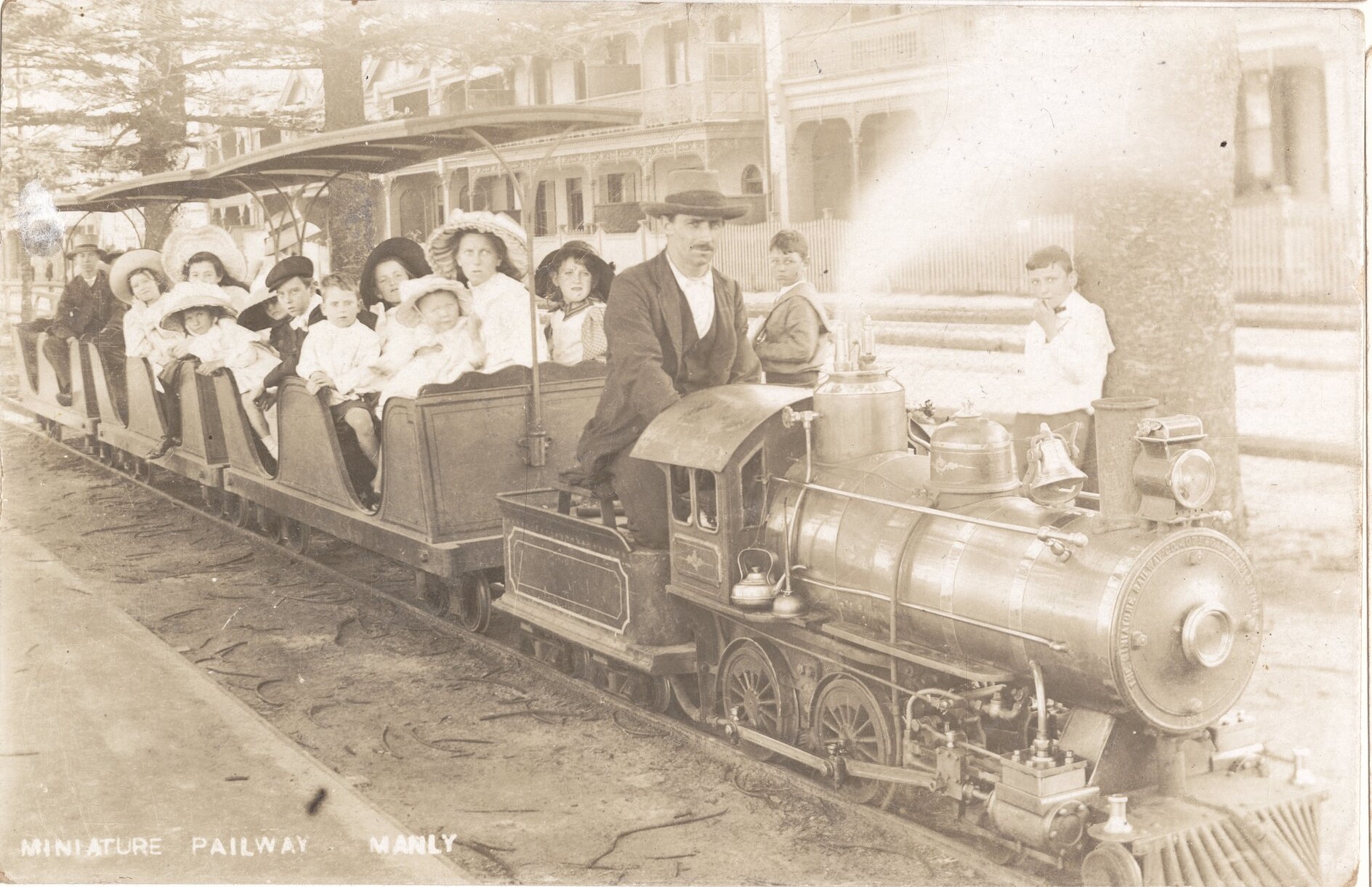
circa 1905. Item: FL11287791, courtesy NSW Records and Archives.
Described in a 1905 advertisement as “the very latest American sensation”, the miniature train ran along the beachfront between The Corso and Raglan St. from 1904 until 1906 when it was put up for sale.
A news report from soon afterwards tells us:
RECENT IMPRESSIONS OF SYDNEY
LIFE IN MANLY.
As the writer resided during the greater part of the dying year in this fine marine suburb, and exercised his pedestrian power in all directions of this extensive pleasure resort, he is competent to give his views of it with something of the authorly of a guide book. It is simply impossible to overrate Manly as a sea lung of the metropolis. It is, without exaggeration, the Brighton of the Southern Babylon. As a spot for a day's outing or a short visit it admittedly stands unrivalled in the whole of Australasia. It has its defects and drawbacks as a matter of course. The sea way to it is occasionally rough between the Heads. The boats are often dangerously over crowded. The sea beaches, surprisingly beautiful in themselves, owe very little to the taste and enterprise of man. There are no gardens, and there is a mournful dearth of music, and the customary amusements of the seaside are not found at Manly. But the surf bathing on Ocean Beach is simply magnificent, and its sometimes dual character does not deduct from its attractions.
By those who do not relish open sea bathing, the ladies' and gentlemen's enclosed baths on Harbor Beach are affected, while sufferers from rheumatism and allied disorders may get both pleasure and relief from a course of hot saltwater baths provided in the vicinity of the now defunct water chute.
The youngsters are exceedingly well catered for in Manly. In addition to Gypsy Smith's famous brace of merry go rounds in the Corso, there is Pearse's string of well trained .beach donkeys, to say nothing of a run on the miniature railway and a glance through the moving picture room, called the mutoscope.
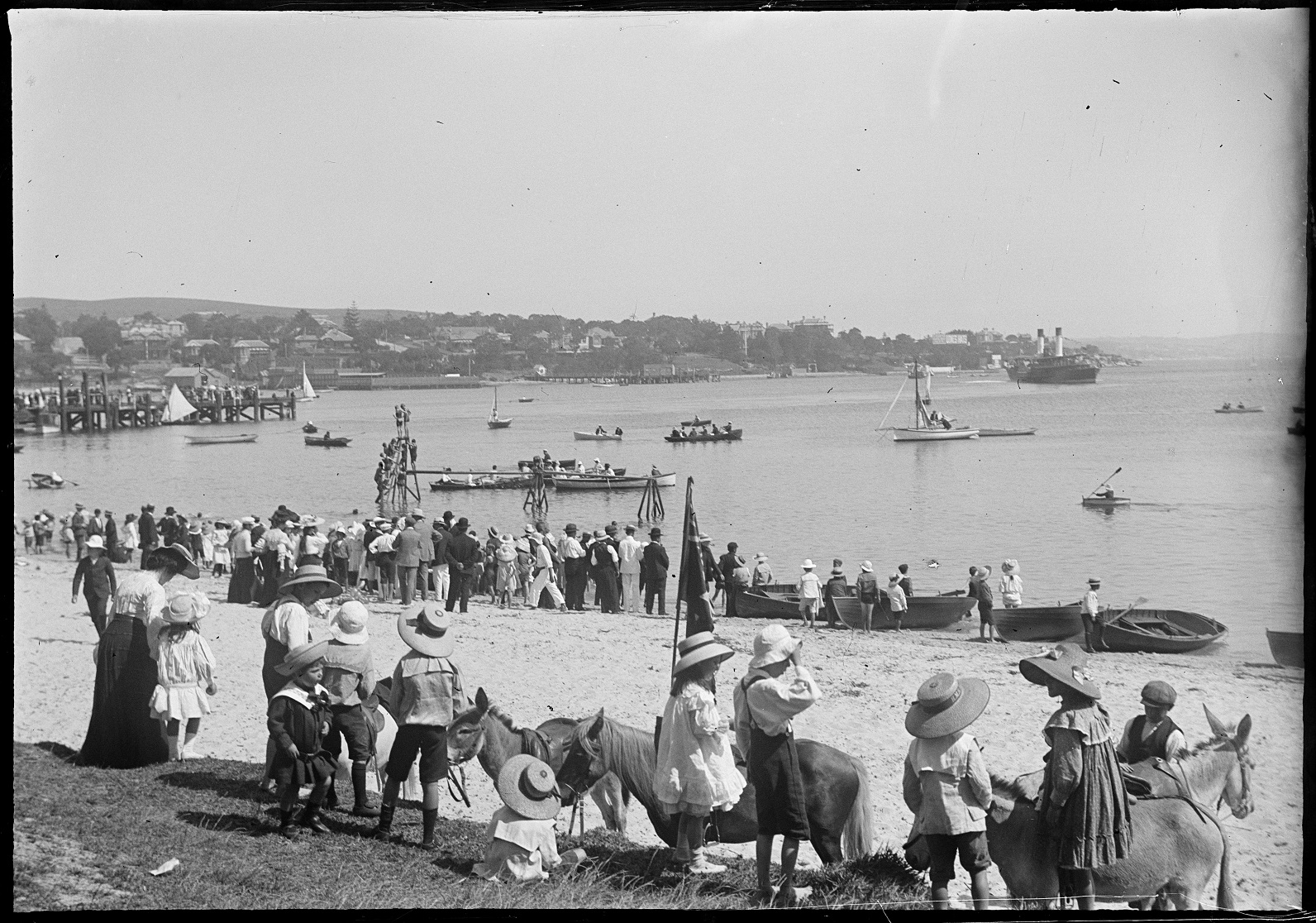
Donkeys at Manly, from Macpherson albums 'Glass negatives of Sydney regions, including Clovelly, Coogee, and Manly ca 1890-1910'. Item: SLNSW_FL3426821 courtesy Mitchell Library, State Library of New South Wales
Manly abounds in picturesque walks and drives. The Spit, 2 1/2 miles away, shows, in parts of it, most romantic scenery. A steam ferry is in evidence here, connected with a tram line On the other side, which runs to Mosman only a mile away. The Spit route to Manly is a favourite one, and is very generally taken when the sea is rough at the Heads.
A coveted resort for picnicers is Shelly beach, and good fishing is to be got in its vicinity. Deewhy Beach, Narrabeen, and Newport are accessible by coach and motor bus, and the track thither passes through most picturesque qoastal scenery. The Corso is quite a unique business thoroughfare, and shows a marvellous array of refreshment rooms, which on fine days, and especially during the holidays, are rushed by city visitors out for a change and a breath of sea air. RECENT IMPRESSIONS OF SYDNEY— LIFE IN MANLY. (1906, December 15). The Muswellbrook Chronicle (NSW : 1898 - 1955), p. 2. Retrieved from http://nla.gov.au/nla.news-article107781779
However, this wasn't the only amusements at Manly:
MINIATURE. EARLS COURT FOR MANLY
It has long been a subject for remark amongst English and American visitors to Australia that our beautiful seaside resorts, so well provided with natural attractions, should be so entirely, lacking in popular amusement enterprises. Take the case of Manly, for instance. The sole amusements provided for the recreation of those who patronise "the Australian Brighton" consist of two somewhat antiquated merry-go-rounds, and a few melancholy-looking donkey on the ocean beach.
A determined effort is being made at last to remove this reproach. Mr. A. L. Baird, who has recently returned from England, after an absence of five years, has succeeded in forming an influential syndicate to carry out an extensive amusement scheme. About two acres of land fronting the ocean beach, and in the immediate vicinity of "Fairy Bower," has been secured, and work has already begun on the erection of the English and American sensation, the "water chute." In addition, a toboggan, slide, fiery dragon (a novel form of motor railway), band stands, refreshment rooms, etc., will be installed, together with an up-to-date electric lighting plant. It is understood that a limited company will he floated in a few days to take over the property of the syndicate. The general manager will be Mr. A. L. Baird, under whose supervision the grounds (to be known in future as "Steyne Court") are being fitted up. Manly is likely to be highly popular this summer. MINIATURE. EARLS COURT FOR MANLY. (1903, October 7). The Daily Telegraph (Sydney, NSW : 1883 - 1930), p. 9. Retrieved from http://nla.gov.au/nla.news-article237581106
Manly is now more than up-to-date, having a "chute" in summer, Continental surf-bathing, and public motor cars. Boys toboggan down Red Hill, and a tram (not quite of the latest design) runs from the wharf to Curl Curl. Of cabs there are plenty. A merry-go-round, the proprietor of which is so rich that he uses sovereigns for his coat and trouser buttons, is permanently undercover in the Corso. The streets are well lighted with gas, though the spaces between them is so narrow that one side has to be the back yards of the other thoroughfare's houses. This style of road architecture is accounted for by the fact that the bullock team and the short-cutter to the ocean beach were the earliest street architects.
The question of a tramway from Watson's to Manly is actively discussed, there being many opinions, both for and against. Meantime Manly appears both happily and prosperously situated, and is going ahead.
THE SUBURBS OF SYDNEY. (1904, June 25). Evening News(Sydney, NSW : 1869 - 1931), p. 3 Supplement: EVENING NEWS SUPPLEMENT. Retrieved from http://nla.gov.au/nla.news-article113903625
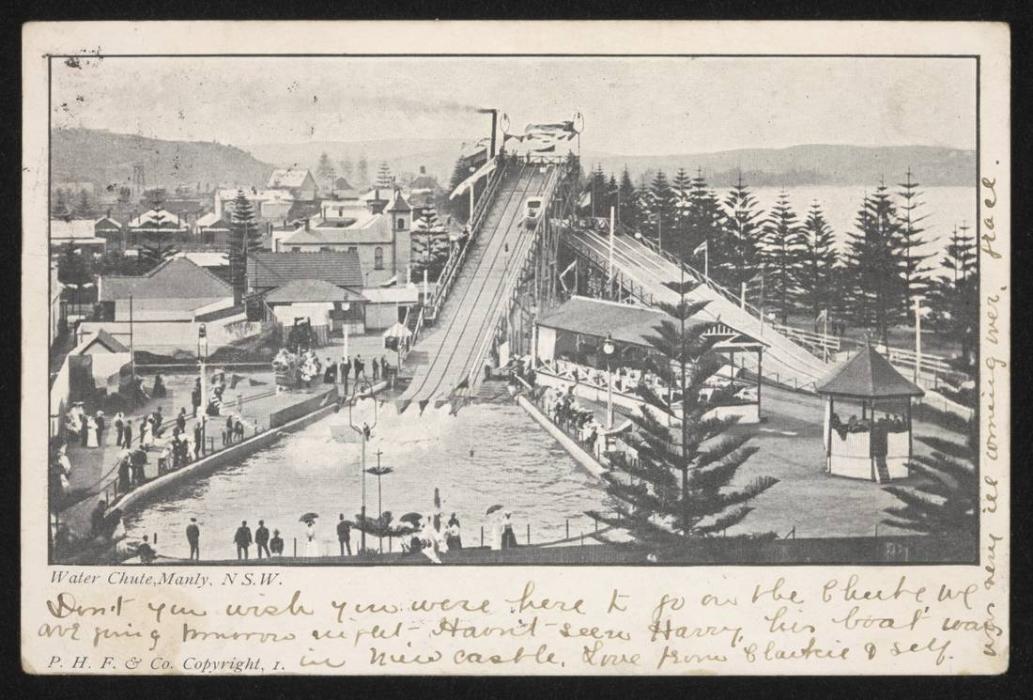
THE MANLY CHUTE.
The Manly Water Chute and Amusements Company have issued an attractive guidebook profusely illustrated, setting forth the numerous attractions at the company’s grounds at Manly. The chute, toboggan. Bijou Theatre, and the fiery dragon are all depicted, and the letterpress is well and smartly written. Trippers to Manly (the Brighton of Australia) who have not yet experienced the sensation of " chuting" on reading the brochure, will no doubt be tempted to " take the plunge." The little book is a credit alike to its author, printer, and all concerned. THE MANLY CHUTE. (1904, May 7). Watchman (Sydney, NSW : 1902 - 1926), p. 3. Retrieved from http://nla.gov.au/nla.news-article111920950 Water Chute, Manly, N.S.W. , courtesy National Museum of Australia, Image No.: 1986.0117.0258 - from an old Postcard.
And this certainly wasn't the first 'amusement' for youngsters and oldsters at Manly - another earlier one, by the 'founder of Manly' was:
MANLY.-CAMERA OBSCURA.-Parties desirous of renting the tower in which the above is placed, and establishing a photographia apparatus therein, can obtain particulars on application to Mr. H. G. SMITH, Manly. MANLY.-TO ENGINEERS. - CONTRACTS are invited for the erection of a small steam-engine, and to lay down the requisite pipes for supplying the baths now in course of erection at Manly. Particulars can be ascertained on application to Mr. H. G. SMITH, Manly. 071) Advertising. (1857, January 13). Empire (Sydney, NSW : 1850 - 1875), p. 1. Retrieved from http://nla.gov.au/nla.news-article60276812
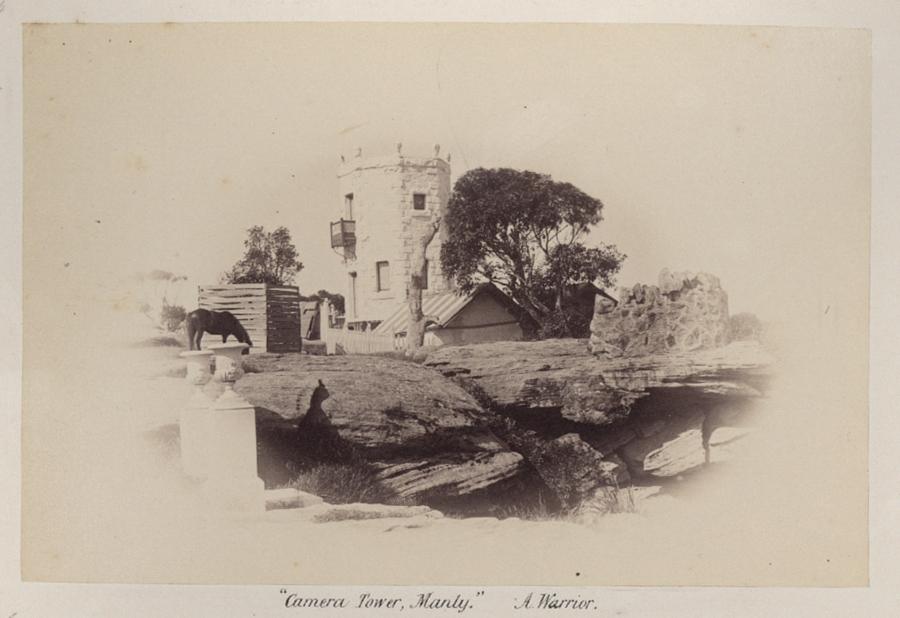
1884 - 1886: By Warrior, A. Contributed by Graham Trevena [Page 4a] (from the album 'Works by Members of the Amateur Photographic Society of N.S.W presented by the Society to His Excellency Lord Carrington August 1886') - retrieved from The Dictionary of Sydney.
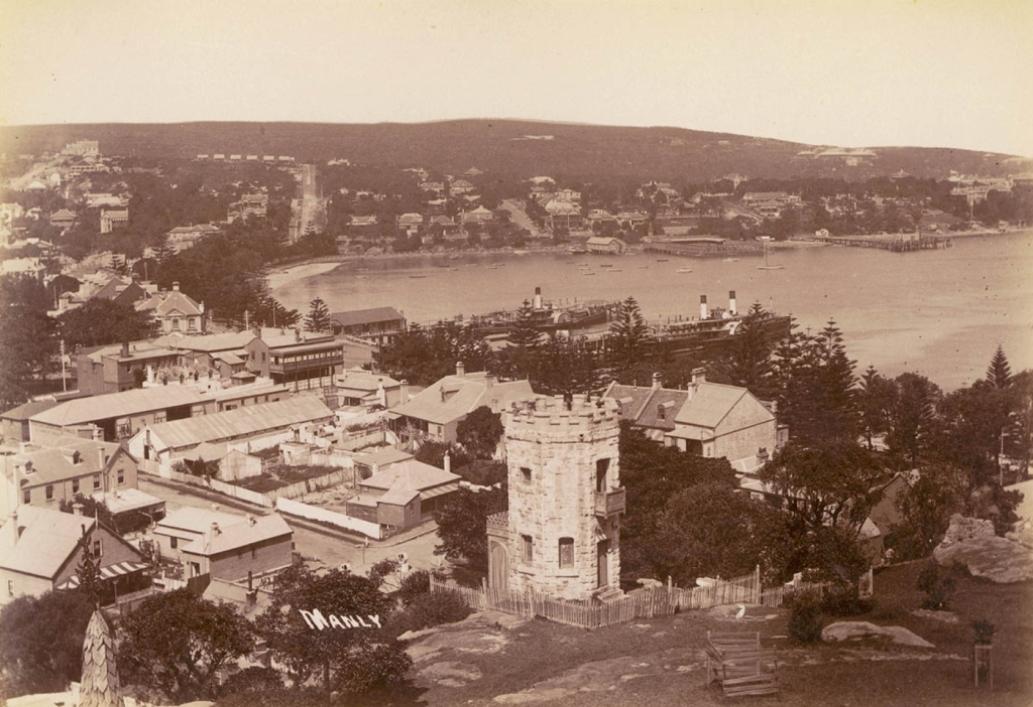
View - Manly [possibly from Dalley's Castle] - shows original Camera Obscura - Date of Work ca. 1900-1910, Image No.: a116266, courtesy State Library of NSW.
How to Make a Camera Obscura:
The Camera Obscura.
In making a camera obscura the first thing we want to know is the focal length of the lens we are going to employ, as upon this will depend the size of the box we have to use.
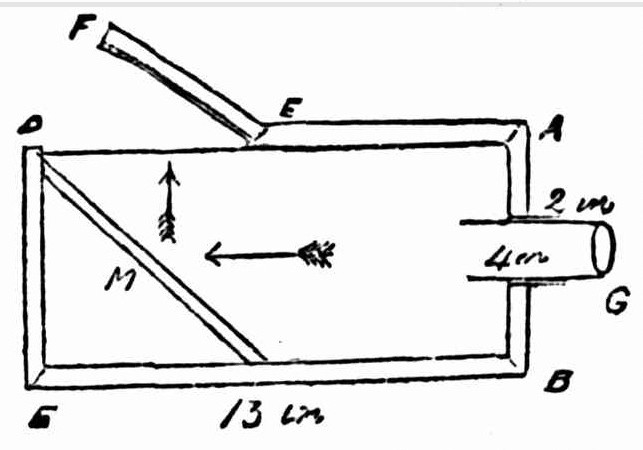
The length of the box has to be rather less than the focal length of our lens. Thus, if the focal length of our lens for objects some yards off be say 15 inches, we may make our box 13 inches long and about 8 inches deep, and 8 inches wide. A round hole must be made into one end (a. /), just sufficiently large to allow the tube containing a double convex lens to work backwards and forwards smoothly (Fig. 1). A mirror (in) is fixed at the other end, at an angle of 45', so that it reflects all light coming from the round hole upwards in the direction of the arrow. One portion of the side ( a d) is made into a door (c /), turning on hinges at e. At e d a square plate of ground glass or smooth glass may be placed, just as required. And now as to the double convex lens. A paper tube may be made of such a diameter as to hold it at one end, and in passing we may say that such paper tubes are very readily made by rolling the paper round a wooden cylinder of requisite diameter, and, as each turn of paper is wound on, gumming it well down. When the gum is dry a good tube is procured. Around the paper tube that has been made another may now be wound, about two inches long, and this will have to be fixed to the hole at the end of the box (a b ), so that the tube of lesser diameter containing the lens may slide backwards and forwards. Paint the inside of the box black, and of the tubes too. And now, if everything be in order, we may proceed to work with our camera. The ground glass is fixed at ed, the lens at g, focussed for the external street or landscape, and we now find them pictured on the ground glass in form and colour mavellously like the scene without. If we wish to make a drawing, the ground glass must be replaced by a sheet of clear glass, and on this tracing paper may then be fastened down, and with a sharp pencil point the outlines of the picture are now readily drawn.
The camera obscura has been employed for warlike as well as gentle purposes, and it was used in this way on the occasion of the defence of Venice in 1859. The Austrians who held the city were afraid that the Italians might suddenly come upon them, and part of their defensive measures was the erection of a large camera obscura (Fig. 2).
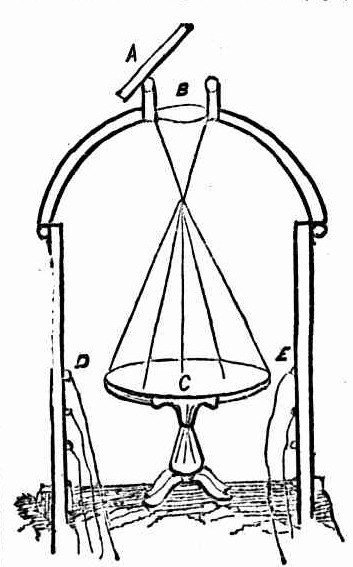
You will perceive from the figure that this camera when built was not unlike the one you have perhaps now made, for there is a double convex lens (6) at one end of it, and at the other a screen (e) in the shape of a table with a white -top. The Venetian camera was built on a rock overlooking the harbour, so that by means of a looking-glass at a a beautiful picture of it was cast on to the table, and it is apparent that a person standing by the table could see the movements of all vessels, whether of peace or of war, that came towards the city. Torpedoes were now sunk in the harbour, and the point where each numbered torpedo was sunk was marked on the table. Torpedoes, as you may be aware, are fired by means of wires leading from them to the shore, and in this case to the inside of the camera (d c),hence at the end of the operation torpedoes had been planted in different parts of the harbour, and the soldier within the camera could tell exactly where each one was, and which wires communicated with it, so that he had it in his power, while watching the picture on the table, to blow up any Italian ship that might come near one of the sunken torpedoes. The Camera Obscura. (1886, February 6). The Sydney Mail and New South Wales Advertiser (NSW : 1871 - 1912), p. 307. Retrieved from http://nla.gov.au/nla.news-article162811341
Mr Meredith, the comedian, has, with much labour and expense, fitted up a Camera Obscura of very large dimensions. We believe it is the first of the kind which will be exhibited in Australia. It may be seen at Macquarie Fort this day, and will be seen on the Race Course during the playing of the Cricket Match on Monday next. ANNIVERSARY REGATTA. (1839, January 26). The Australian (Sydney, NSW : 1824 - 1848), p. 2. Retrieved from http://nla.gov.au/nla.news-article36859496
THE STORY OF THE CAMERA
Any boy or girl can have a camera nowadays for a few shillings and take pictures with hardly any trouble. But it is not many years since photography was more a difficult business than a pleasure, and less than a century since the earliest camera was made. Photographic films and plates are coated with gelatine and a silver substance which is sensitive to light, and which makes a permanent picture of whatever the camera lens sees. It was in 1732 that a scientist named Schulze discovered that this silver was darkened by the light, but his discovery was put to no practical use until early in the 19th century. At that time there was a fashion for making silhouettes. Somebody was posed so that the light from the lamp threw the profile of his face in sharp shadow against a white screen. It was then easy to obtain a silhouette picture by either outlining the profile or cutting it out from the screen. But it occurred to a man named Wedgwood that the profile might be printed on the screen by using paper treated with silver nitrate, and he not only accomplished this, but also made the camera obscura, the forerunner of the camera we use today.
Then Sir Humphrey Davy succeeded in making photographs through a microscope by using the sunlight These were the first pictures produced by a lens on photographic material ; but it was not until Sir John Herschel discovered hypo that the proofs could be made permanent. In about 1840 Daguerre invented his process of making pictures on copper which was silver-plated on one side. But by his methods anyone sitting for a photograph was a martyr. The poor victim had to stay motionless in the sun for many minutes with face thickly coated in powder. So, little by little, improvements were made until the first film roll camera appeared in 1888. After that, taking a photograph took less time, and loading and unloading could be done in daylight. And most recently has come autographic photography, so that the amateur, by putting a date and a title on each negative after exposing it, may make a written record of his work as well as a pictorial one. THE STORY OF THE CAMERA. (1919, August 10). Sunday Times (Sydney, NSW : 1895 - 1930), p. 21. Retrieved from http://nla.gov.au/nla.news-article123222323
And that first miniature train wasn't the only one to run at Manly - here's one from the early 1930's - on the beach itself:
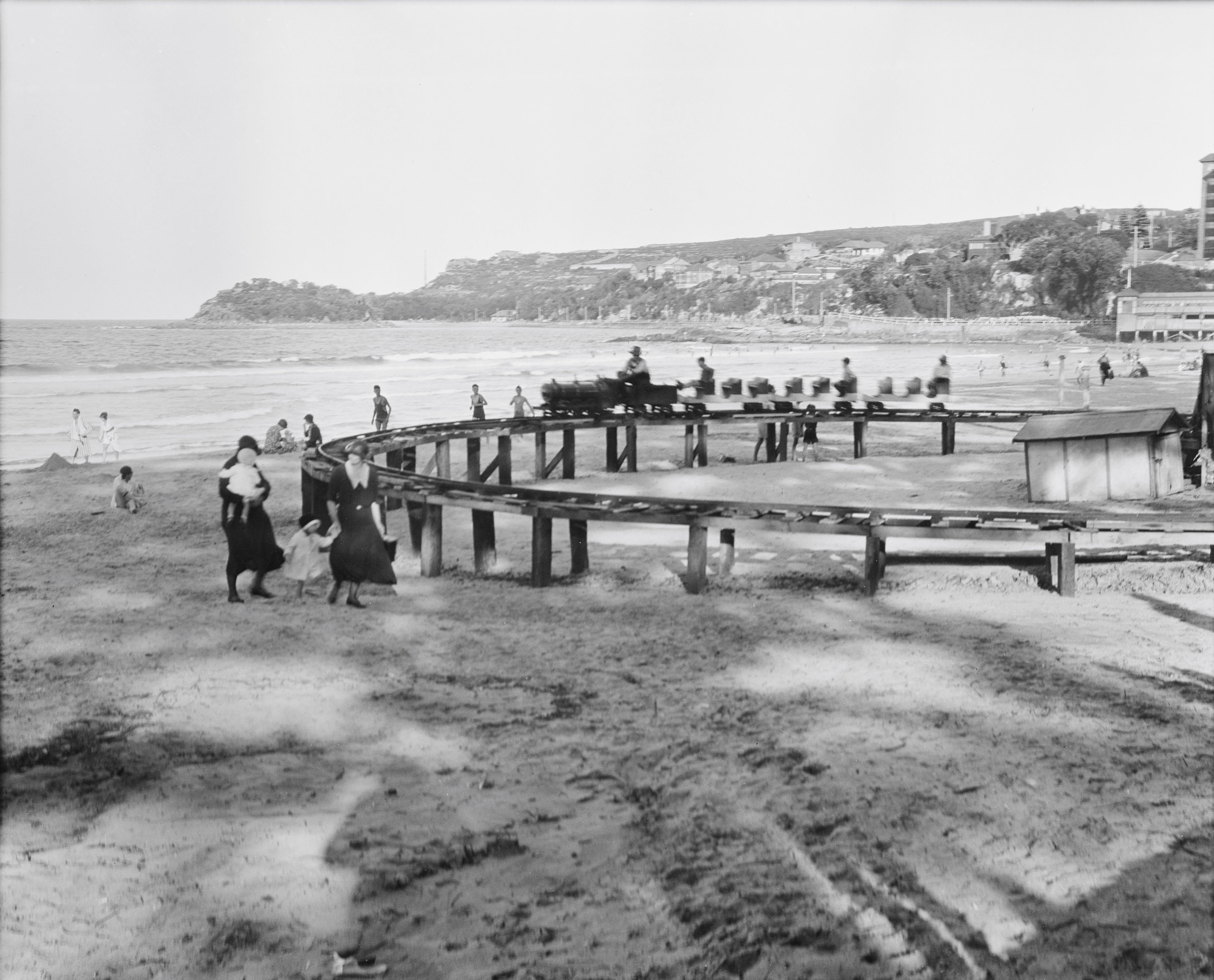
Train ride, Manly Beach, from album 'Series 02: Photographs chiefly of Manly, N.S.W., Melbourne, and Victoria, ca. 1900-1932 by Henry Edwin Quick'. Item: SLNSW_FL345354, courtesy Mitchell Library, State Library of New South Wales
Palliasses being spread, and after a general clean up and tea, it was heigh-ho! for Manly. Here the lads made a name for themselves as heavyweights by breaking the miniature railway on the beach, where the sand modeller deservedly drew and held their interest. BLACKHEATH SCOUTS (1931, March 26). Lithgow Mercury (NSW : 1898 - 1954), p. 7 (TOWN EDITION). Retrieved from http://nla.gov.au/nla.news-article221856759
The Metropolitan Band will give morning and afternoon recitals on the Manly wharf, and broadcast from 2BL this evening. Mr. John Palmer will conduct.
Car-drivers making for the beaches beyond Narrabeen to-day will find the bridge over Narrabeen Lakes open for traffic. It has been under repair for nearly two months. WHERE TO TO-DAY? (1931, October 5). The Daily Telegraph (Sydney, NSW : 1931 - 1954), p. 1. Retrieved from http://nla.gov.au/nla.news-article246564790
Of course, there were amusements for children further north as well:
RAMBLER NOTEBOOK -
HAPPY HOLIDAY
The other day the family and I came back from a very enjoyable holiday at Avalon Beach. Fishing and surfing took up most of the time but one red-letter night, a circus pitched its tent not very far from where we were staying. Trained elephants, horses, dogs, lions, and monkeys were all included in the entertainment, as well as clowns, acrobats, trapeze artists and tightrope walkers. One horse played football and kicked a ball with his hind legs into the audience. Another day a couple of friends and I went fishing at Pittwater for the day. Some bream and a couple of leather-jackets were all we caught. (Blue Certificate to Bruce Salmon (12), 66 Findlay-avenue, Roseville.) RAMBLER'S NOTEBOOK & HOBBIES (1942, March 1). The Sun (Sydney, NSW : 1910 - 1954), p. 7 (SUPPLEMENT TO THE SUNDAY SUN COMICS). Retrieved from http://nla.gov.au/nla.news-article231759658
Aerial picture of Avalon Beach around 1935 shows what looks like a big circus tent in today's named 'Old Barrenjoey Road. Photo courtesy ABHS
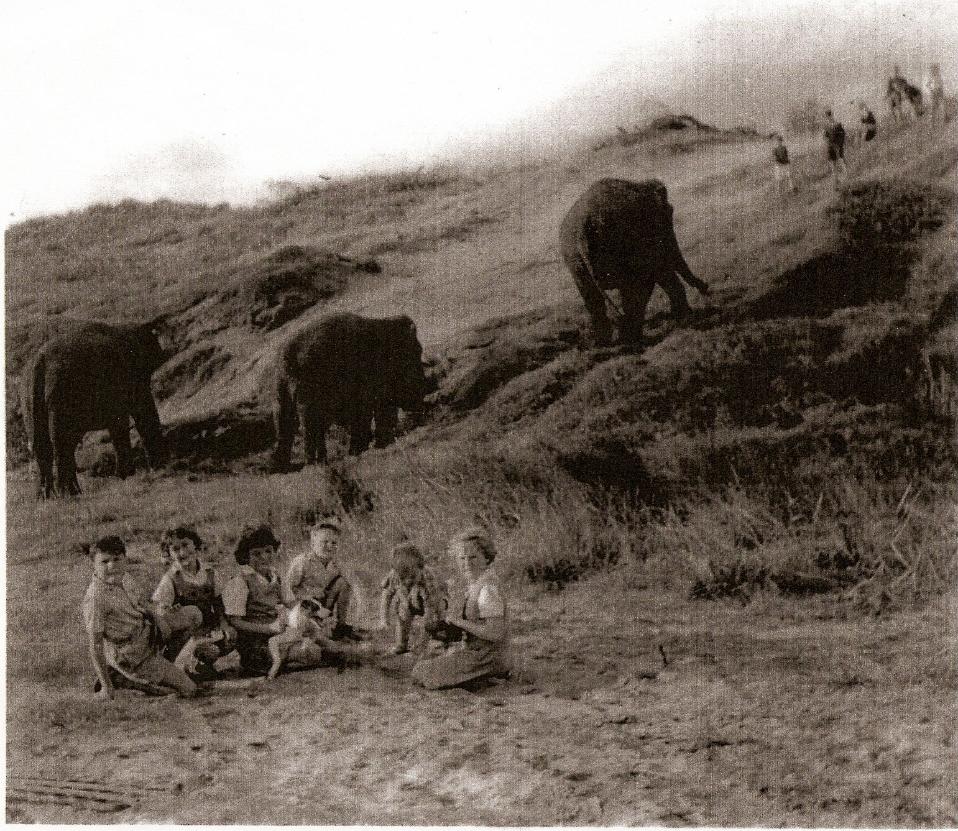
Circus comes to Avalon. Elephants graze in the dunes in the 1960s. Poor dunes! No wonder the sand began to blow. Photo: ABHS